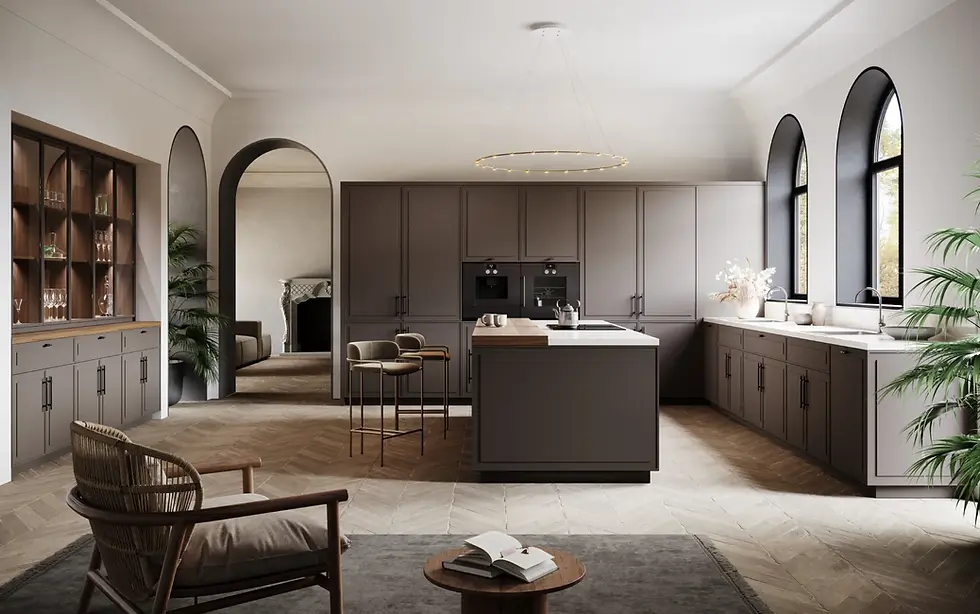European Cabinets 101; The 3-Part Anatomy of Custom Cabinetry
- Daniel

- Feb 10, 2023
- 3 min read
Updated: Mar 27, 2023
Custom cabinetry isn’t rocket science, but having a basic knowledge of the components
and features of European cabinetry enables you to make informed decisions.

Overview
Asking what’s so special about European cabinets is like asking what’s so special about Mercedes Benz. Even though we may find custom cabinetry as compelling as luxury vehicles, we understand that not everyone does, so let’s knock this out – it’s a quick class.
A cabinet consists of three main parts:
The box or structure.
The front-facing exterior doors, drawers, and panels seen from the outside.
The internal hardware, for instance, hinges, drawer slides, and all nifty specialty items like corner cabinetry and trash pull-outs that make the spaces so functional and efficient.

1.) The Box
Of the three cabinet components, the box is the simplest. The main difference between European-style and traditional US-made cabinets is the face frame; European cabinets don’t have them. A face frame is a solid wood flat face around the front perimeter edge of the cabinet. A European-style cabinet box is literally a box, typically built out of ¾-inch material with a +/- ¼” thick backing, depending on the manufacturer.
European cabinets are almost always built out of fiberboard. We love all those high-end brands, like Poggenpohl, Leicht, Siematic, and Poliform – they are all made from the same thing: you guessed it, fiberboard.
In a future blog post, “3 Words That European Kitchen Cabinetry Showrooms Don’t Like”, I’ll go into more detail on this subject. For now, it’s enough to say that many consider plywood a superior material for cabinet structures compared to fiberboard, though it’s not so cut and dry. Luckily, our Austrian-made TEAM 7 cabinets are built from solid wood for folks that ascribe to that belief, and our Italian custom cabinetry has an upgrade option to make their boxes out of plywood instead of fiberboard.
2.) Faces & Panels
The faces and panels refer to everything visible from the outside: doors, drawers, and various boards and fillers, all in the material and finish of your choice. These can range from matte solid-color Italian-made Fenix material to high gloss lacquers, wood veneers, engineered faux wood, and so much more – the choices are vast. In a future blog post, “It’s Not Just Wood; Material Options for European Cabinetry,” we’ll cover this subject in more detail. However, choosing what you like is best while considering durability and maintenance.
This second component of European cabinets is why many folks choose them in the first place, as most European material options are better in quality and the available finish selections. Other materials, such as ceramic door faces and matte glass fronts, can only be found in Europe – they aren’t produced anywhere else. This factor alone can make the decision process that much easier.

3.) Hardware
Much like the unique faces and fronts that Europe produces, no one can match the engineering quality and the smooth functionality of German precision-made hardware. Hinges and drawer slides glide effortlessly; they are a joy to open and close. Hardware is fully adjustable in all directions, so fronts can line up beautifully to give that seamless flush and super clean look. Uplift hardware from world-famous German producer Blum completes the ubiquitous modern European design, with extra-wide fronts that glide upward in several different lifting mechanisms, allowing for a range of designs and a look that is impossible with US and Canadian-made cabinets.
Then there are the more oversized hardware items, with various corner cabinets, pull-outs, and organizational systems, frequently made by another prominent and respected German manufacturer: Kessebohmer, the gold standard for these larger functional inner mechanisms. Many of these parts are exported from Europe around the world and used by local cabinetmakers in their builds, but plenty of items can still only be found in Europe. When fully integrated into the system in European factories, there are considerable cost savings compared with buying the materials individually here in the States.

Putting It All Together
This brings us to the final and unifying point of why European cabinets are unique and superior to their US and Canadian-made counterparts – it has to do with scale. The cabinetry industry in Europe is on a factory scale, particularly in Germany. The large manufacturers use just-in-time inventory and base their technological systems on the automobile industry, with companies like Volkswagen making some of the robotics used to manufacture cabinets – it’s highly advanced. This means that order fulfillment is much better, and build tolerances are tight to a fraction of a millimeter. If we order cabinets that are 610mm wide, for example, they are 610mm wide, exactly. This is not nearly the case with local shop-made cabinets.
Add it all up, and European cabinets are simply better.
That’s why I decided to gracefully exit my local custom cabinetry shop at SF Custom Cabinets in 2016 and pursue only European cabinetry. If you can’t beat ’em, join ’em.



This overview of material options for European cabinetry is incredibly insightful—balancing aesthetics with durability is key in modern design. Speaking of visual appeal, it's equally important to inspect the clarity and consistency of your digital displays when showcasing material finishes or design mockups. You can easily perform black screen test online with blackscreen onl to reveal any screen imperfections like dead pixels or uneven backlighting. This seamless, full-screen charcoal view is perfect for interior designers and architects who rely on accurate visual representation. No installations needed—just a clean, efficient tool that enhances display calibration across devices.